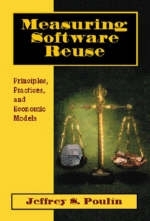
Measuring Software Reuse
Addison Wesley (Verlag)
978-0-201-63413-6 (ISBN)
- Titel ist leider vergriffen;
keine Neuauflage - Artikel merken
With the techniques in this book, you will have the tools you need to design afar more effective reuse program, prove its bottom-line profitability, and promote software reuse within your organization. Written by a leading software reuse practitioner, Measuring Software Reuse brings together all of the latest concepts, tools, and methods for software reuse metrics, presenting concrete quantitative techniques for accurately measuring the level of reuse in a software project and objectively evaluating its financial benefits. The book addresses all of the many factors involved in a software reuse program: determining what constitutes software reuse-looking at COTS software, operating systems services, tools, code libraries, and more; how to measure the level of reuse in a project; and how to analyze the costs incurred by a software reuse program. You will also find detailed explanations of the various economic models used to evaluate the financial benefits of a reuse program such as cost avoidance, value added, payoff threshold, return-on-investment, and cost-benefit analysis.To further your understanding, the book presents experience-tested techniques for implementing a metrics program by incorporating a recommended reuse metric "starter set.
" It also includes an extensive discussion on the metrics for reuse libraries and examines the issue of measuring reuse throughout the software life cycle. 0201634139B04062001
Jeffrey S. Poulin is a Senior Programmer with Lockheed Martin Federal Systems where he works on software architectures and reuse strategies for a variety of software development projects across Lockheed Martin. In addition to performing reuse metric and economic analysis, he serves as the technical lead for the Lockheed Martin Federal Systems reuse program. Formerly, Dr. Poulin worked in the IBM Reuse Technology Support Center where he led the development and acceptance of the IBM software reuse metrics and ROI model. 0201634139AB04062001
(Most chapters conclude with "Conclusion".) Foreword. Preface. 1. Motivating Software Reuse Through Metrics. Terms. Expected Levels of Reuse. Expected Benefits of Reuse. This Book Will Explain . . . . 2. A Reuse Metrics Overview. Metric Goals and Requirements. Reuse Percent-The De Facto Standard Measure of Reuse Level. Reuse Leverage Models. Reuse Economic Models. Conclusion. 3. The Relative Costs of Developing with and for Reuse. The Relative Cost of Reuse. The Relative Cost of Writing for Reuse. Calculating Your Own Values for RCR and RCWR. Conclusion. 4. Defining Reuse from a Metrics Point of View. The Boundary Problem. What to Measure as Reuse. Applying the Counting Rules to Object-Oriented Software. Common Questions About What to Count. Conclusion. 5. Measuring Reuse and Reuse Benefits. Banker et al.: Reuse Metrics. Frakes and Terry: Reuse Level. Gaffney and Durek: Reuse Economics. Balda and Gustafson: Estimation Using Modified COCOMO. Barnes and Bollinger: Cost-Benefit Analysis. Henderson-Sellers: Cost-Benefit Analysis. Malan and Wentzel: Cost-Benefit Analysis with NPV. Poulin and Caruso: Reuse Metrics and ROI. Defense Information Systems Agency: Reuse Metrics and ROI. Conclusion. 6. Implementing a Metrics Program. Management Structure for Software Reuse. The Software Development Process with Reuse. A Reuse Metric Starter Set. Case Study: Applying Reuse Metrics on a Project. Maintaining a Reuse Metrics Program. Conclusion. 7. Measuring Software Reusability. Motivation. A Taxonomy of Reusability Metrics. Empirical Methods. Qualitative Methods. A Common Model for Reusability. Domain Considerations. Conclusion. 8. Metrics for Reuse Libraries. Recommended Metrics. Reuse Library Efficiency. Conclusion. 9. Measuring Reuse Across the Life Cycle. LOC Works as an Overall Indicator. A Method to Quantify Total Life-Cycle Reuse. Conclusion. 10. Conclusions and Future Directions. Summary. Where Do We Go from Here? Appendix A. Reuse Metric Worksheets. Appendix B. Reuse Metric Calculator. Appendix C. Reuse Metric Glossary. Appendix D. Acronyms. Appendix E. Recommended Reading. References. Index.
| Erscheint lt. Verlag | 13.1.1997 |
|---|---|
| Verlagsort | Boston |
| Sprache | englisch |
| Maße | 241 x 165 mm |
| Gewicht | 320 g |
| Themenwelt | Informatik ► Office Programme ► Outlook |
| Mathematik / Informatik ► Informatik ► Software Entwicklung | |
| ISBN-10 | 0-201-63413-9 / 0201634139 |
| ISBN-13 | 978-0-201-63413-6 / 9780201634136 |
| Zustand | Neuware |
| Haben Sie eine Frage zum Produkt? |
aus dem Bereich


